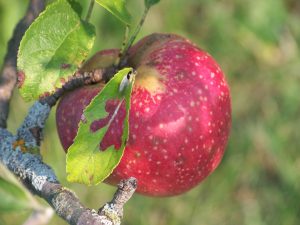
September, with the smell of fall caught and blowing around in the trees as Keats inevitably rustles inside my head: season of mists and mellow fruitfulness…. One afternoon I take a break from my massive sabbatical writing project — which features among other things Keats (of course), John Cage, Marina Abramovic, yoga, gardening, pottery, snails, Jane Bennett, Hannah Arendt, Adolf Eichmann, war, empathy, “forcible rape,” fracking, whale songs, fish that make “crop circles” (is this not amazing??!!!), Maurice Merleu-Ponty, tigers, honeybees, Syrians, and George Orwell — and drive out to one of my favorite places to gather free heirloom apples. Because it’s apple-butter time.
And this year, there’s something new in the orchard: Gloucestershire Old Spots pigs, penned in movable fence under the apple trees to eat windfalls. We never had pigs on our farm in Alabama when I was a child, and like the rest of the country we’ve got a wild hog problem now, but I’ve always been fascinated by pigs, even as there’s something faintly unnerving about their obvious alertness and intelligence. (Orwell, who knew his way around a smallholding and had not only a vegetable garden but chickens and a goat named Muriel, made pigs the ringleaders in Animal Farm for a reason.) They’ll tear up your leg or your dog if you catch them wild, out hunting; they’ll root the hell out of your young longleaf pines or quail or turkey nests; if you were a Methodist child like me, you may be haunted by images of the Gadarene swine. Yet looking at these pigs in their fall-afternoon bliss, nosing and sampling windfall apples, flicking their floppy ears and grunting just to hear themselves talk, I thought, something about this feels right.
Anthropologist Gregory Bateson told a story about being at New College, Oxford, and hearing them talk about replacing the huge oak timbers: “there’s some more oaks out back,” he recalls the men saying, “a couple hundred years old, planted just for this” — and then, he says, “I thought, ‘that’s the way to run a culture.'” If you think about culture the way I do, as a life-sustaining human presence in a world to which it is responsible, made and grown in layers over time by layers of touch — that is my current working definition of culture, touch matured by time — you ask yourself, how can technology alone ever approach this sort of warm, lively, and sustaining intimacy? How can we ever build a real and enduring culture without honoring living things and learning from their relationships? Bateson wrote a lot about this. And when you look at pigs in an orchard, you see it in action.
While pigs, like dogs, are resourceful enough to go feral, they’ve also always lived close to people, feeding off byproducts of small-farm life: whey, cider pressings, vegetable scraps, and – yes – windfall apples. When I make cheese (just a basic ricotta, so far) and end up with a bowl full of whey, I always wish for a pig to feed it to, like we used to toss old watermelon rinds and cornshucks over the fence for the horses and cattle. Taking compost down to the worm bin is a subtle delight — look how what was grown from this soil and eaten in this house now feeds other creatures in this house and goes back to this soil! — and it makes me wish for more animals to thrive on what I can’t use. Chickens… alas, they don’t work in my life for now. Honeybees, in city limits, are illegal. Pigs, of course, are right out.
But I can still enjoy these Old Spots under their heirloom apple trees in Iowa, and understand more deeply the webs of household and agricultural and historical interconnection in which I still live because of them. Old Spots are the oldest breed in England, chosen pig of the Royal Family’s table, and the spots, folklore says, first came from apples falling on them — although nobody really knows how old this breed may be, it’s very, very old. Remembered on a warm fall afternoon, this story heightens your quiet happiness in being here where human and animal history meet, and braid together. And that’s the way to run a culture.
